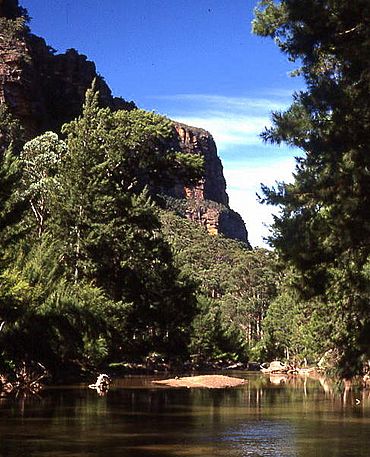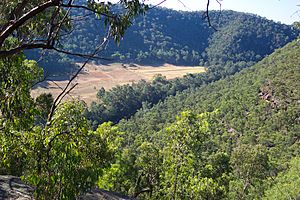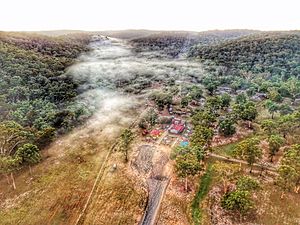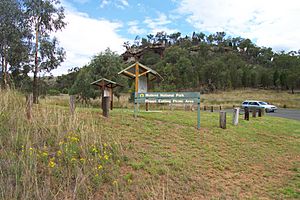Wollemi National Park facts for kids
Quick facts for kids Wollemi National ParkNew South Wales |
|
|---|---|
|
IUCN Category Ib (Wilderness Area)
|
|

Capertee River, located within the southern portion of the national park
|
|
| Nearest town or city | Lithgow |
| Established | December 1979 |
| Area | 5,017 km2 (1,937.1 sq mi) |
| Managing authorities | NSW National Parks and Wildlife Service |
| Website | Wollemi National Park |
| See also | Protected areas of New South Wales |
The Wollemi National Park is a special protected area in New South Wales, Australia. It is located in the northern Blue Mountains and Lower Hunter areas. This huge park covers about 5,017 square kilometers (1.2 million acres). It is the second largest national park in New South Wales.
Wollemi National Park is home to the amazing Wollemi Pine (Wollemia nobilis). This tree was thought to be extinct for millions of years until it was found in 1994. Special efforts were made to protect these rare trees during the big bushfires in 2019-2020.
In 2000, Wollemi National Park became part of the UNESCO World Heritage-listed Greater Blue Mountains Area. This means it is recognized as a very important place for everyone in the world. The park is also part of the Great Dividing Range, a long mountain range in Australia.
Contents
Exploring Wollemi's Landscape and Rocks

Wollemi National Park sits on the western edge of the Sydney Basin. The park's landscape is shaped by different layers of rock. These include sandstone and shale. Over time, wind and water have worn away some of these rocks. This has created the park's amazing deep valleys, canyons, cliffs, and waterfalls.
The soil in the park can be very different. Some areas have shallow soil with few nutrients. Other areas have deeper, richer soil. This allows for many different kinds of plants to grow. You can also see older rock layers, like coal measures, along the river valleys.
Rivers and Waterways
Wollemi National Park is important for keeping many rivers clean. These rivers flow into the Hawkesbury River and Goulburn-Hunter River systems. Rivers like the Wolgan River, Colo River, and Capertee River flow through the park. The Colo River is known as one of the cleanest rivers in New South Wales. This is because most of it flows through the protected national park.
Amazing Plants and Animals
Wollemi National Park is full of life! About 90% of the park is covered by open forests with many types of eucalypt trees. There are over 70 different kinds of eucalypts here. The rest of the park has rainforests, heathlands, and grasslands.
This variety of habitats means many different animals call Wollemi home. Scientists have recorded:
The Secret Wollemi Pine
The most famous plant in the park is the Wollemi Pine (Wollemia nobilis). Before 1994, this tree was only known from fossils. It was thought to have died out about 30 million years ago! Then, a small group of these trees was found hidden in deep canyons within the park. To protect these incredibly rare trees from diseases and damage, their exact location is kept a secret.
Other special plants in the park include the Wollemi Mint Bush and a rare type of Banksia. A new kind of eucalypt tree, the Wollemi Stringybark, was also found here.
Ancient Aboriginal Sites
Wollemi National Park is a very important place for Aboriginal Australians. There are many ancient sites within the park. These include cave paintings, places where tools were sharpened, and rock carvings.
In 2003, a special site called Eagle's Reach cave was announced. Bushwalkers found it in 1995. A team from the Australian Museum explored the cave in 2003. The art inside this small cave is thought to be up to 4,000 years old! It has many layers of images drawn with ochre and charcoal. The team counted over 200 separate pictures, mostly of animals and birds. There are also stencils of hands, axes, and a boomerang. This site is very important, and its remote location is kept secret to protect it.
Fun Activities in the Park
Wollemi National Park offers many exciting activities for visitors:
- Bushwalking: Exploring the trails and enjoying nature.
- Canyoning: Descending through canyons, often involving walking, scrambling, climbing, jumping, abseiling, and swimming.
- Canoeing: Paddling along the rivers.
- Camping: Spending the night under the stars.
- Abseiling: Climbing down cliffs using ropes.
One popular camping spot is Ganguddy Campground, located on the Cudgegong River. The local Wiradjuri Aboriginal people know this area as Ganguddy. It is also called Dunns Swamp. The NSW National Parks and Wildlife Service manages this beautiful spot.
Historical Places to Discover
The area around Wollemi National Park has a rich history. Some interesting historical places include:
- Wolgan Valley
- Newnes
- Newnes glow worm tunnel
- Zig Zag Railway
- Oil shale Mining sites
- Glen Davis
Images for kids
See also
 In Spanish: Parque nacional Wollemi para niños
In Spanish: Parque nacional Wollemi para niños





